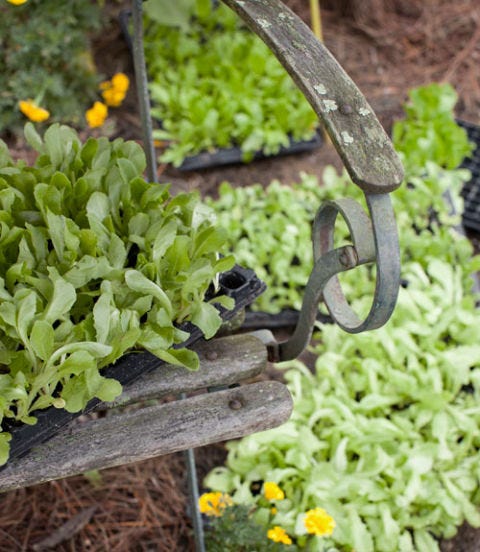Small Space Vegetable Gardening Ideas
1. Choose a spot. The first step to creating your own organic kitchen garden is choosing the ideal spot: a flat, level site — near a water source — that receives eight hours of sunlight a day. Next, you'll want to get a handle on the quality of your dirt.
2. Test the soil. Squeeze a handful of soil into a ball. It should hold together yet break apart evenly. If you get a hard mass, there's too much clay; if it won't hold together at all, the problem is sand.
3. Check the pH. Vegetables desire acidic soil, with a pH between 5.5 and 6.5. Most nurseries sell a test kit for under $10 (Antler King, $8.99; woodburyoutfitters.com). Or send a soil sample to your local co-op extension (csrees.usda.gov/extension).
4. Amend the soil. Begin with organic compost, layering on a few inches in the spring and again after fall harvest. Depending on your soil issues — sand, clay — you may need to add mulch (to help retain moisture) or sand (to aid with drain-age). A layer of pine straw can increase acidity. For more details, consult The Practical Organic Gardener ($15.95; Silverleaf Press), by Brenda Little.
5. Or gain complete control with raised beds. Raised beds allow you to start from scratch soil-wise. Visit gardeners.com for easy-to-assemble beds from $40. For crops that require depth—carrots, sweet potatoes—consider tall containers, like a three-foot-high barn-wood box; your back will thank you!

Victoria Pearson
6. Sow those seeds. Read the packets. Even the most experienced gardeners turn here for info about depth and spacing.
7. Get a head start indoors. In colder climates, cultivate long-season, warm-weather vegetables (eggplants, peppers) inside. Burpee makes a fuss-free kit (XL Ultimate Growing System, $19.95; burpee.com), or try these 10 everyday items that make perfect seedling starters.
8. Plant outdoors once all danger of frost has passed. Before you move seedlings — or sow seeds directly — outside, consult the Old Farmer's Almanac for typical temperate dates in your zone (almanac.com).
9. Water the right way. Reward vegetables with a deep root soak; watering the leaves can lead to powdery mildew. To be safe, opt for a simple drip-irrigation system (Rain Drip Landscape, $27.62; sears.com).
10. Avoid under- or overwatering. Purchase a moisture meter (Bond Moisture Meter, $7.64; amazon.com) to make sure you're watering the right amount.
11. Fend off pests. Build fencing to block out animals. Mesh netting virtually disappears, yet still foils most furry thieves. When dealing with deer, go a minimum of eight feet tall. To stop rascally rabbits, install the barrier to a depth of at least eight inches under the soil surface.
12. Repel aphids and slugs organically. Use a topical pepper spray (Hot Pepper Wax, $9.75 for 32 ounces; amazon.com). The scent of marigolds helps deter aphids and other small pests. Floating row covers also provide an impenetrable barrier.
13. Feed those plants. Apply an organic foliar spray, like Jon Carloftis's Bloom & Fruit, weekly ($33.90 for 32 ounces; 859-940-9696).
14. Support climbers. Birch teepees provide structure for cucumbers, beans, and peas.
This content is created and maintained by a third party, and imported onto this page to help users provide their email addresses. You may be able to find more information about this and similar content at piano.io
Small Space Vegetable Gardening Ideas
Source: https://www.countryliving.com/gardening/garden-ideas/tips/a4110/vegetable-garden-tips/
Posted by: seasedeaders50.blogspot.com

0 Response to "Small Space Vegetable Gardening Ideas"
Post a Comment